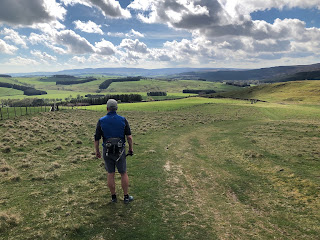I did say I would be visiting a lot of places on writing this blog and maybe not in a structured and ordered way. The main reason is that working at home means I end up thinking about and reading about yoga, then a thought will occur to me and this needs to be shared in some fashion.
In yoga, there are some very pointed ways of describing the states of our mind and worth sharing, because as runners we meet them
ALL the time. In fact, as runners, these states of mind are amplified so when you stop running you can continue to be aware of these states of mind in your non-running lives. Bringing awareness to our mind is a crucial aspect of training and sport.
In yoga philosophy, there is a recognition and an awareness of three states of mind called the 'three Gunas'. Being aware of these three states of mind and recognizing when you are IN them is THE very subtle but important point. A general point but in Eastern thinking, all objects have more or less of some of these qualities of the mind. I like these descriptions and they do help me and hopefully, you get a sense of how our mind can fluctuate over time with these descriptions.
As runners, you have experienced these three states of mind namely Tamas, Rajas and Sattva mind. All three moves in and out of phase either quickly, slowly or as I have met, out of control.
Tamas has many definitions but the descriptions I often use and suggest is a mind in a state of inertia, or sluggishness and an extreme state of the Tamas mind may be certain types of depression. Other words come to mind here as well, namely apathy, helplessness and maybe laziness. However, you need this state for sleep!
In running, getting outside can be difficult, I can't be bothered today is typical but also whilst running this sudden feeling of lethargy is all too often present. I meet it at one hill in particular:) My state of mind becomes Tamas but knowing it will improve after I get over THAT hill is better than being IN the state and have it all-consuming (DNF).
Rajas is a state of energy, action, change, and movement. The nature of rajas is of attraction, longing and attachment and rajas strongly bind us to the fruits of our work. You could also say a Rajas mind is a restless mind.
We need to GO outside, we are restless and yet this drive and energy are essential. Too much can be as problematic as a Tamas mind, this high can appear to be intense and out of control. I have seen this in some events with some runners who seem almost as if their minds and bodies are in a very restless and nervous state.
You could not go to sleep in this state, hence we know this state of
mind in a negative light, this restless and moving mind, we can lie for
hours watching our mind flit from image to image and thought to thought
in our beds!
 |
| Find space, find harmony. |
Sattva is a state of harmony, balance, joy, and intelligence. We perhaps wish more of this but this is still a human quality of the mind. This state of mind does not last of course. These states move and fluctuate over time and in time,
We are aiming for Sattva, or are we? the runners high the sense of joy and feeling of oneness, but actually, are you attached to this feeling? Not achieving this is also a problem, in other words, your attachment to these three states of mind is NOT the same as a Yogi mind. A yogi mind is free from these states of mind.
A quick overview of the three states of mind as described and defined by the science of Yoga. Next time you are in a yoga class or running just note where your mind is, what state is it in? A yoga class should focus on the breath and the quality of the breath to begin to control these states of mind. Awareness of your breath is the beginning of a transformation. You cannot change unless you become aware? More on this later:)
See you on the mat
Nick







